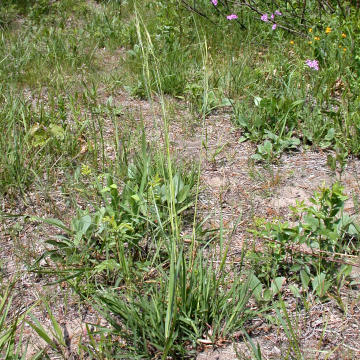

Stipa spartea - (image 1 of 6)
Taxonomy
Family: Poaceae
Habitat
Frequent in dry prairies. Sandy oak savannas. open woods. Scattered dry habitats
Associates
In dry prairies with Andropogon gerardii, Andropogon scoparius, Anemone cylindrica, Aster ericoides, Comandra umbellata, Coreopsis palmata, Euphorbia corollata, Heuchera richardsonii, Lespedeza captitata, Phlox pilosa fulgida, Ratibida pinnata, Silphium terebinthinaceum, Sisyrinchium albidum, Solidago rigida, Sporobolus heterolepis. In sandy Black Oak savanna with Artemesia caudata, Aster azureus, Aster linariifolius, Helianthus divaricatus, Liatris aspera, Lupinus perennis occidentalis, Panicum villosissimum pseudopubescens, Quercus velutina, Rosa carolina, Solidago speciosa, Tephrosia virginiana, Tradescantia ohioensis.
Distribution
MI and IN, west to ND and WY, south MO to NM. Occasional in dry habitats in OH, Ontario, and PA.
Morphology
Perennial grass, to 4' high, arching when seeds are mature. Leaves often more than 6" long, narrow elongate, often involute; sheaths glabrous; ligules of the upper leaves to 1/4", the lower much shorter, blades to 1/4" wide, glabrous beneath, scabrous and usually also hairy above, the lower elongate, tapering to a fine point. Spike an open or contracted panicle, nodding, 4-8" long, the few branches with 1 to few large spikelets; spikelets one flowered, articulated above the glumes; glumes about equal, lance-linear, papery, with broad scarious margins, more than 1" long; first glume 3-veined; second glume 5-veined, the nerves parallel only, the middle one extending to a prolonged tip; lemma brown, villous at the base, terete, linear, obscurely nerved or nerveless, shorter than or equaling the glumes; awn terminal, elongate, stiff, twisted, to 6" long, articulated with the lemma but persistent.
Notes
Flowers early June to mid June
Wetland indicator: Upland
The needlegrass tribe Stipeae, in the subfamily Pooideae, includes the genus Stipa (or Hesperostipa), the needle grasses. These grasses have a large awn fixed to the lemma. The awn is twisted and highly hygroscopic, twisting and untwisting with changes in moisture. This serves to drive the floret into the ground to plant it or work its way into the wool or skin of grazing animals. The seeds can make a mess of cloth storage receptacles.
This species is also called Hesperostipa spartea (Trin.) Barkworth.
References
Chapman, G. P. and W.E. Peat. 1992. An Introduction to the Grasses (including
bamboos and cereals).
C-A-B International
Clark, G. Lynn and Richard W. Pohl. 1996. Agnes Chase's First Book of Grasses:
The Structure of Grasses Explained for Beginners. Fourth ed.
Smithsonian Institution Press. Washington and London
Gleason, Henry A. and A. Cronquist. 1991. Manual of Vascular Plants of
Northeastern United States
and Adjacent Canada. Second Ed.
The New York Botanical Garden. Bronx, NY
Swink, F. and G. Wilhelm. 1994. Plants of the Chicago Region.
Indiana Academy of Science. The Morton Arboretum. Lisle, Illinois.
|
Michael Hough © 2005 |